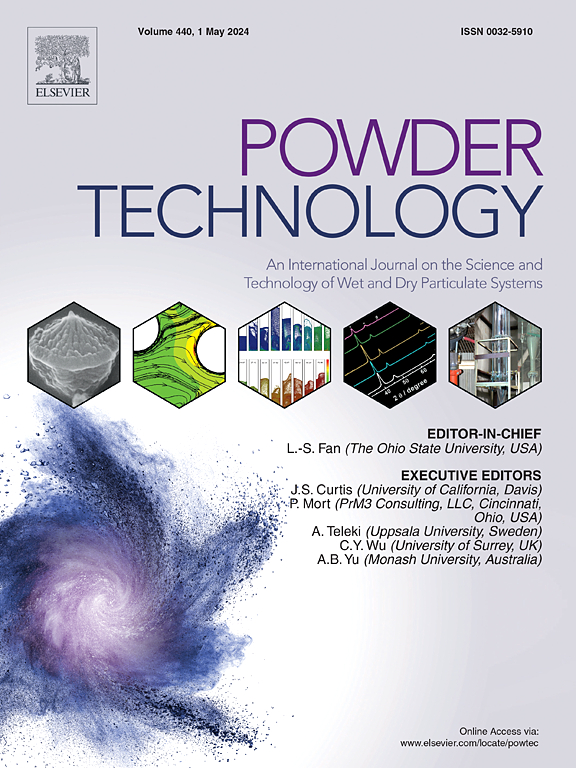表面粗糙度和粒径对球形颗粒材料剪切特性的影响
IF 4.5
2区 工程技术
Q2 ENGINEERING, CHEMICAL
引用次数: 0
摘要
本研究旨在系统探讨颗粒尺寸和表面粗糙度对球形颗粒材料剪切力学行为的影响机理。采用喷砂技术制备了不同粒径(2mm、3mm、4mm)的玻璃微珠。与光滑玻璃微珠一起作为室内三轴固结排水(CD)试验的试验原料。在定量表征颗粒表面粗糙度的基础上,从颗粒尺寸效应(R)、表面粗糙度指数(Ra)和归一化粗糙度效应(Ra/R)等方面讨论了球形颗粒材料剪切力学性能的差异,包括应力-应变曲线、强度参数、临界状态特征和粘滑行为等。主要研究结果表明:提高颗粒表面粗糙度可以在一定程度上改善各种剪切力学参数。这包括有效提高峰值偏应力,扩大强度包络范围,提高临界破坏状态下试样对应的偏应力。它能显著提高峰值摩擦角φ约10% ~ 40%,临界状态线斜率(CSL斜率)约5% ~ 23%。而且,随着粒径的减小,这种增加变得更加明显。同时,随着归一化粗糙度效应(Ra/R)的增大,摩擦系数增大,大大削弱了颗粒间的粘滑行为。本文章由计算机程序翻译,如有差异,请以英文原文为准。

The effect of surface roughness and particle size on the shear characteristics of spherical particle materials
This study aims to systematically investigate the influence mechanism of particle size and surface roughness on the shear mechanical behavior of spherical particle materials. Rough glass beads with different particle sizes (2 mm, 3 mm, 4 mm) were prepared using sandblasting technique. Together with smooth glass beads, they were used as test raw materials for indoor triaxial consolidated - drained (CD) tests. Based on the quantitative characterization of particle surface roughness, the differences in the shear mechanical properties of spherical particle materials, including stress - strain curves, strength parameters, critical state characteristics, and stick - slip behavior, etc., were discussed from the aspects of the particle size effect (R), the surface roughness index (Ra), and the normalized roughness effect (Ra/R). The main research results show that: increasing the surface roughness of particles can improve various shear mechanical parameters to a certain extent. This includes effectively increasing the peak deviatoric stress, expanding the range of the strength envelope, and raising the deviatoric stress corresponding to the specimen in the critical failure state. It can significantly increase the peak friction angle φ by approximately 10 %–40 % and the critical state line slope (CSL slope) by about 5 %–23 %. Moreover, the increase becomes more pronounced as the particle size decreases. Meanwhile, as the normalized roughness effect (Ra/R) increases, the friction coefficient becomes larger, which greatly weakens the stick - slip behavior between particles.
求助全文
通过发布文献求助,成功后即可免费获取论文全文。
去求助
来源期刊

Powder Technology
工程技术-工程:化工
CiteScore
9.90
自引率
15.40%
发文量
1047
审稿时长
46 days
期刊介绍:
Powder Technology is an International Journal on the Science and Technology of Wet and Dry Particulate Systems. Powder Technology publishes papers on all aspects of the formation of particles and their characterisation and on the study of systems containing particulate solids. No limitation is imposed on the size of the particles, which may range from nanometre scale, as in pigments or aerosols, to that of mined or quarried materials. The following list of topics is not intended to be comprehensive, but rather to indicate typical subjects which fall within the scope of the journal's interests:
Formation and synthesis of particles by precipitation and other methods.
Modification of particles by agglomeration, coating, comminution and attrition.
Characterisation of the size, shape, surface area, pore structure and strength of particles and agglomerates (including the origins and effects of inter particle forces).
Packing, failure, flow and permeability of assemblies of particles.
Particle-particle interactions and suspension rheology.
Handling and processing operations such as slurry flow, fluidization, pneumatic conveying.
Interactions between particles and their environment, including delivery of particulate products to the body.
Applications of particle technology in production of pharmaceuticals, chemicals, foods, pigments, structural, and functional materials and in environmental and energy related matters.
For materials-oriented contributions we are looking for articles revealing the effect of particle/powder characteristics (size, morphology and composition, in that order) on material performance or functionality and, ideally, comparison to any industrial standard.
 求助内容:
求助内容: 应助结果提醒方式:
应助结果提醒方式:


